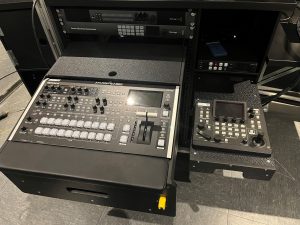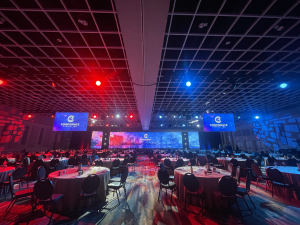- Macros streamline your workflow by allowing you to carry out numerous operations with a single command.
- You can build and trigger complex action lists with macros that include switching, DSK on/off, audio mixing adjustments, and much more
- The V-8HD can store up to 100 macros.
Versatile, portable, and reliable, the Roland V-8HD brings a world of creative options to live event switching. Here, we’ll dive into macros, which streamline your workflow by allowing you to carry out numerous operations with a single command. With macros, you can build and trigger complex action lists that include switching, DSK on/off, audio mixing adjustments, and much more. Macros can also run preset memories and other macros.
If you find yourself pressing several buttons to do certain things during your event, it can help to create a macro for them. For example, perhaps you want to switch between several cameras in a particular order and bring up different still images as graphics throughout switching. The V-8HD can store up to 100 macros. Let’s explore how they work and how to use them to enhance your projects.
Macros Applications
Macros can help you when you need to run complex switching operations with a single button press. They also are useful when you want to animate or dynamically resize a Picture in Picture window. Finally, try macros when you want to cycle through different HDMI and still image assets as DSK graphics sources.
General Setup
You can create and edit macros in the Macro menu on the V-8HD or in the Macro section of the V-8HD Remote app for iPad. Each macro contains up to 10 operations. Below is a list of actions that you can add to your macros.

You can configure each operation to take place all at once or in sequential order. Additionally, you have the ability to copy and swap entire macros and reorder the operations within them.
If you wish to test a macro while creating or editing it, use the Preview function to watch it in action. After the Preview is complete, your settings will revert to their state before running the macro.
Hardware Setup
- Press and hold the Mode button until up to eight of the multi-purpose buttons next to it turn orange.
- If there isn’t a macro in any of those eight slots, it will be unlit.
- Tap the multi-purpose button for the macro that you want to run.
- Wait for the macro to finish before pressing another multi-purpose button.
There are eight buttons to run macros with the V-8HD. Here are a couple of tricks you’ll find in the Macro menu to maximize your hardware.
Menu > Macro > Number of Macro SW > 24: This setting will turn your A and B row buttons into macros 9-24. Note that this disables PGM and PST input selection.
Menu > Macro > SW Assign: Here, you can map specific macros to the buttons and customize the layout. By default, macros 1-8 (or 9-24) are mapped to these buttons.
Remote App Setup
You can also run macros using the V-8HD Remote app. While you can rename macros using the hardware menu, the app makes it quick and easy to rename scenes using the iPad’s touch keyboard.
- Tap the Macro button to open the Macro screen.
- You will see the Execute layout with the macros arranged in two banks of 50 macros each.
- Run macros with these buttons.
Renaming
- Tap the Edit button. You’ll see macros arranged in five banks of 20 macros each, with an edit window below for the macros you select.
- Tap the Name Edit button to change the name of the currently selected macro in the editor.
Glossary
- Alpha Channel: Instead of the DSK removing Luma or Chroma from a source, it uses the Alpha Channel from a PNG file or a graphic system’s key source to determine the transparent areas.
- AUX: A bus that directly outputs a video source other than PGM. It does not support overlays. [Note: You can disable the AUX bus to enable Alpha Channel on the DSK.]
- Bus: A grouping of one or more video sources. The V-8HD has PGM, PVW, AUX, and Multi-View busses.
- DSK: Downstream Keyer. Primarily used for overlaying graphics with transparent areas, and for green screens. The V-8HD supports one.
- Keyer: Removes either Luma (black/white), Chroma (blue/green/custom), or Alpha from the DSK source. [Note: PinP 1 and 2 also support Luma and Chroma key.]
- Macro: A list of timed operations that are executed with a single button press.
- Multi-View: A 10-window output that displays HDMI inputs 1-8, PVW, and PGM.
- PinP: A Picture in Picture window. The V-8HD supports up to two.
- PGM: Program. This is the primary output. It combines the selected video input with any PinP and DSK overlays.
- Preset Memory: Referred to as scenes in this guide.
- PST: A preset (separate from scenes/preset memories). This is the input source that goes to Preview. A common workflow is to first select your PST source before performing a transition. This helps prevent switching mistakes.
- PVW: Preview bus. Swap this with the PGM input when you perform a transition. You can also use this to preview the PinP and DSK layers before sending them to PGM. [Note: To tie PinP and DSK layers to transitions, enable Effects Transition Sync in the System menu.]
- Scene: Referred to as a memory or preset memory in the V-8HD controls and menus. It’s like a snapshot of PGM and menu settings.
- Sequencer: A list of scenes, macros, and input selects that are executed manually or with timings.
- Transition: A cut, dissolve, or wipe between the PGM and PVW video busses.




